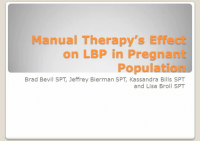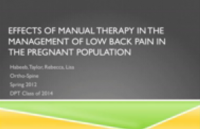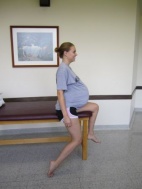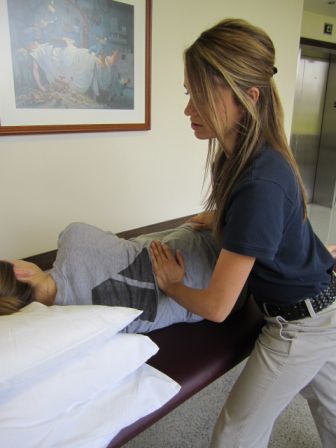Low Back Pain and Pregnancy: Difference between revisions
Aiko Deckers (talk | contribs) No edit summary |
Aiko Deckers (talk | contribs) No edit summary |
||
| Line 18: | Line 18: | ||
<br> | <br> | ||
Figure A: (4) <br> | ''Figure A: (4)'' <br> | ||
<br> | <br> | ||
</div></div></div> | </div></div></div> | ||
== Clinically Relevant Anatomy == | == Clinically Relevant Anatomy == | ||
Revision as of 13:00, 27 December 2013
Original Editors - Timothy Assi
Top Contributors - Lynse Brichau, Aiko Deckers, Admin, Brenda Walk, Corin Arundale, Timothy Assi, Christine Utskot, Joanne Garvey, Kim Jackson, Lauren Lopez, Nicole Hills, Chris Slininger, Rachael Lowe, Temitope Olowoyeye, Joshua Samuel, Uchechukwu Chukwuemeka, Evan Thomas, George Prudden, 127.0.0.1, Jeremy Brady and Laura Ritchie
Search Strategy[edit | edit source]
Pubmed, Medline, Web of knowledge, books.
Definition/Description
[edit | edit source]
Pregnancy related low back pain is a common complaint that occurs in 60-70% of pregnancies [21] and can be defined as pain between the 12th rib and the gluteal folds/pubic symphysis during the course of pregnancy. This pain is not the result of a known pathology
such as disc herniation[25] and can begin at any point during pregnancy. Although most cases are mild, approximately one third of women experience severe pain.[11] Pregnancy related low back has been coined multiple times and can be referred to as one of the following patters: Low Back Pain (LBP), Peripartum Posterior Pelvic Pain (PPPP), Pregnancy-related low back pain (PLBP) or pregnancy-related pelvic girdle pain (PPGP). The last two patterns can occur separately or combined.[21]
Unfortunately, there is limited research available regarding physical therapy intervention for pregnant women experiencing Low Back Pain, so a homogenous approach tends to be used. However, back pain is not homogenous; therefore special considerations and precautions should be taken when treating this population.
Figure A: (4)
Clinically Relevant Anatomy[edit | edit source]
The lumbar region is constituted of five unique vertebrae that are designed to withstand increased weight and retain a lordotic curve. The vertebral canal of the lumbar region houses the tail end of the spinal cord and the Cauda Equina.
To maintain stability and provide support, the lumbar region is connected and held secure by an intricate web of ligaments: ligamentum longitudinale anterior and superior, ligamentum flava, ligamentum interspinata, ligamentum intertransversarium and the ligamentum supraspinale. All the mentioned ligaments will provide stability, whereas the longitudinal ligament will also be attached to the intervertebral disc in order to keep the discs in position. Additionally, the lumbar region is supported by strong low back muscles, pelvic muscles and abdominal muscles.
Epidemiology /Etiology[edit | edit source]
A number of reviews investigated the prevalence of low-back pain during pregnancy in different populations. The results are inconsistent, ranging from 8% to more than 89% of women who complain of low back pain during pregnancy.[10][19][20][21][22][23][24]
The exact etiology and pathogenesis of pregnancy related LBP is unknown, but it seems to be the consequence of circulations changes, hormonal and mechanical factors. In addition, previous back pain history, multiple abortions (evidence level 2C) and smoking are considered contributing risk factors that may increase the symptoms.[5][9][22][21][26][17] Some contradictory studies suggest that age, weight and height of the mother, fetal weight, and the number of pregnancies are not risk factors. [23][20]
The prevalence of pregnancy related low-back pain is the highest during the third trimester.[9][24] One of the more common reasons is a condition called Diastasis Rectus Abominis, which is the separation of the Rectus Abdominal at the Linea Alba, leading to poor posture and LBP.[25]
Characteristics/Clinical Presentation[edit | edit source]
There are several possible mechanisms of injury which could be causing pregnancy related LBP. During pregnancy, changes occur in the facet joints, in the back muscles, and in ligaments. This is mainly caused by the increased release of the hormone Relaxin,[11] which causes ligament laxity, and therefore can affect the stability of the spine and lead to back pain.[12]
Another contributor is the increase in weight. On average, about 11-15 kilograms are gained during pregnancy.[12] The weight gain increases the amount of force placed across joints, changes the center of gravity, and forces the patient into an anterior pelvic tilt. The anterior displacement of the center of gravity will cause women to shift their heads and upper body posteriorly over the pelvis, causing hyperlordosis of the lumbar spine. This in turn, places additional stress on the intervertebral discs, ligaments, and facet joints and can lead to joint inflammation.[14][15] In addition, abdominal muscles are stretched and weakened, and the added weight can compress on the lumbosacral plexus.[13]
The most common onset tends to be during the 5th and 6th month of pregnancy, and the pain is usually worse in the evening. About 67% of women experience pain at night. Factors that aggravate the pain include: standing, sitting, coughing or sneezing, walking, and straining during a bowel movement.[15] However pain and a disability of the lumbopelvic region are usually proven to be experienced as mild to moderate, except for a minor part (20%) of the pregnant women that will describe the pain as severe. [28]
Differential Diagnosis[edit | edit source]
Some other diagnoses that can be commonly mistaken for pregnancy related low back pain are: Sciatica, Meralgia Paresthetica, thoracic/rib pain, hip pain, coccygodynia, spontaneous abortions, osteomyelitis, osteoarthritis of spine or hip, Cauda Equina Syndrome, Osteitis Condensans Ilii, metastatic cancers, and Diastasis Rectus Abdominis. Other more common differential diagnoses are: disc disease, facet joint involvement and sacroiliac joint involvement. It is important to be able to recognize the subtle differences and differentiate between the comorbidities.(6)(30)
“Disc Disease - Morning pain and stiffness, pain when weight bearing, pain with increased abdominal pressure, history of repeated micro trauma, pain when going uphill, pain with prolonged sitting, pain with sit to stand activity. Sleep is usually undisturbed, pain eases as day progresses and then gets worse again, movement eases pain but not for long (e.g. fidgets).”(6)
“Facet Joint Involvement - Non weight bearing pain, pain with related to movement (specifically rotation), pain increased by lateral compression, history of minor injury, pain is not usually referred to an extremity, pain eases with rest, not affected by coughing or sneezing”(6)
“Sacroiliac Involvement - Pain is usually unilateral and does not midline, can refer to lower extremities, turning while in supine provokes pain, getting out of the car provokes pain, pain is referred to the groin or genitals, pain is related to menstruation prior to pregnancy because of the effects of cyclic hormones on pre-pregnant SIJ ligaments.”(6)
Diagnostic Procedures[edit | edit source]
In order to formulate the correct diagnosis, the patient should be questioned about her past medical history. It is important to concentrate on experienced symptoms, limitations in activities, and movement possibilities. Questions about past pregnancies such as – "Have you experienced any complications with prior pregnancy(s)?" are appropriate. This will help the therapist understand the patient’s health problems and needs. Knowledge of the anatomical and functional disorders, activity limitations and restriction of participation will help the therapist determine her/his role and the need for appropriate interventions. It is important to recognize red flags complaints and contact a doctor if they are present.[9]
Outcome Measures[edit | edit source]
Different measure instruments can be used in the diagnosis to estimate the complaints more objectively: Visual Analogue Scale (VAS)[10], Roland Disability Questionnaire (RDQ), Impact on Participation and Autonomy (IPA), Photograph series Of Daily Activities (PHODA), and Pain Behavior Scale (PBS).
Examination
[edit | edit source]
Physical Exam
Examination should include observation of the posture and gait, neurologic screen to rule out underlying pathology, range of motion, muscle tests, palpation, muscle length tests, and assessment of joint mobility. Even though the Active Strait Leg Raise test seems accurate, the sensitivity will be elevated when combined with the Posterior Pelvic Pain Provocation (PPPP) test. [27] Special tests can include FABER and Trendelenberg. The following findings are commonly revealed: Paravertebral muscles are tender to palpation, back muscles weakness, decreased ROM in flexion. The description of the pain is often not localized and may be intermittent. It is possible for the pain to radiate down as far as the calf.[5]
SI Joint Examination: If the patient is unable to stand, instruct the patient to lie in supine and perform a pelvic bridge. The bridge will place the pelvis in neutral - the ASIS’ can be palpated for symmetry.
Medical Management (current best evidence)[edit | edit source]
As a physical therapist, it is important to ask the patient if they are having regular check ups by their obstetrician, and if they have any contraindications regarding exercise. A variety of precautions should be taken to manage LBP during pregnancy. Some interventions include: encouraging sidelying while sleeping (can be assisted by using a wedge-shaped pillow), using compression socks to promote venous return to the heart and reduce edema, support belts, soft tissue massage, acetaminophen use if approved by MD (NSAIDs are contraindicated).
While further researcher is needed, the use of support belts has preliminarily been shown to be an effective tool for decreasing pain intensity, duration and effect on ADLs. One such belt is The Loving Comfort support belt which is covered by Medicaid.[1]
Precautions include: Avoiding heavy lifting, holding breath while performing exercises, no moist heat on lower back, ultrasound, and electrical-stimulation.
According to the American College of Obstetricians and Gynecologists, exercise should be avoided if the following signs or symptoms are experienced:
Vaginal bleeding, dizziness or feeling faint, increased shortness of breath, chest pain, headache, muscle weakness, calf pain or swelling, uterine contractions, decreased fetal movement, fluid leaking from the vagina.[2]
Physical Therapy Management[edit | edit source]
Managment includes specific interventions to address pain, weakness, and mobilty in the pelvic girdle and low back region. After reviewing the research, common interventions that were found to be effective included: two maual therapy techniques and three therapeutic exercises.
The way of treatment depends on the diagnosis and timing of pregnancy (before or after childbirth). Firstly, the patient should understand her own symptoms and be motivated to remain active. Back care advice [3] and exercise during second half of the pregnancy [4] significantly reduces LBP. Postural education can prevent unnecessary mechanical stress on the back [5], therefore neutral postures during ADL and physical activities are recommended. Stability, coordination and functional preservation should be trained with active back exercises - endurance training for back muscles stabilization.[6] Pelvic tilts, knee pull, straight leg raising, curl up, lateral straight leg raising and water aerobics are recommended because it relieves lumbar pain in pregnancy.[5]
Manual Interventions:
[edit | edit source]
Posterior/Anterior Mobilizations in Sidelying to address pain and mobility (Grades 1-4).
Muscle Energy Technique by resisting hip flexion while stabilizing the sacrum (to correct anterior innominate rotation)
Exercises:
[edit | edit source]
Strengthening gluteus medius with clams in sidelying position.
Image:Marching_with_ADIM_small.jpg
Abdominal Drawing in Maneuver sitting on physioball. Can progress exercise by combining ADIM with lower extremity marching.
Latissimus dorsi pull-downs with glute sets to increase the strength of the posterior oblique sling mucles, which compress the SIJ.
Aerobic exercise: Walking, swimming, recumbent bicycle (or nustep), at a low to moderate intensity. The stress on the back should be minimal.
Resources
[edit | edit source]
Here is another page concerning lower back pain in pregnancy.
Clinical Bottom Line[edit | edit source]
Many pregnant women experience low back pain. Key questions must be asked and special modifications must be made with physical exam and treatment. Therefore, as patient centered practitioners, it is our job to research and implement evidence based practice to increase outcomes with minimal number of treatments with this special population.
Presentations[edit | edit source]
 |
Effects of Manual Therapy in the Management of Low Back Pain in the Pregnant Population
This presentation, created by Brad Bevil, Jeffrey Bierman, Kassandra Bills, and Lisa Broll; Texas State DPT Class. |
 |
Effects of Manual Therapy in the Management of Low Back Pain in the Pregnant Population
This presentation, created by Habeeb Adewale, Lisa Elliot, Rebecca Hogan, Taylor Clark; Texas State Class of 2014, Evidence-based Practice projects for PT7539 Ortho Spine course. |
Recent Related Research (from Pubmed)
[edit | edit source]
Failed to load RSS feed from http://eutils.ncbi.nlm.nih.gov/entrez/eutils/erss.cgi?rss_guid=14MpKbWO9zvFebubT4UTZKZm_0Q0VJ_VKdfcgw_JcJ0AWU29XI|charset=UTF-8|short|max=10: Error parsing XML for RSS
References
[edit | edit source]
- ↑ Cite error: Invalid
<ref>tag; no text was provided for refs namedSandler - ↑ Cite error: Invalid
<ref>tag; no text was provided for refs namedSneag - ↑ Cite error: Invalid
<ref>tag; no text was provided for refs namedOrvieto - ↑ A. Garshasbi, S. Faghih Zadeh.The effect of exercise on the intensity of low back pain in pregnant women. International Journal of Gynecology and Obstetrics.2005; 88, 271—275(B)
- ↑ 5.0 5.1 J Sabino, Jonathan N. Grauer. Pregnancy and low back pain. Curr Rev Musculoskelet Med. 2008; 1:137–141(D)
- ↑ Cite error: Invalid
<ref>tag; no text was provided for refs namedMeeusen
</div></div></div>









